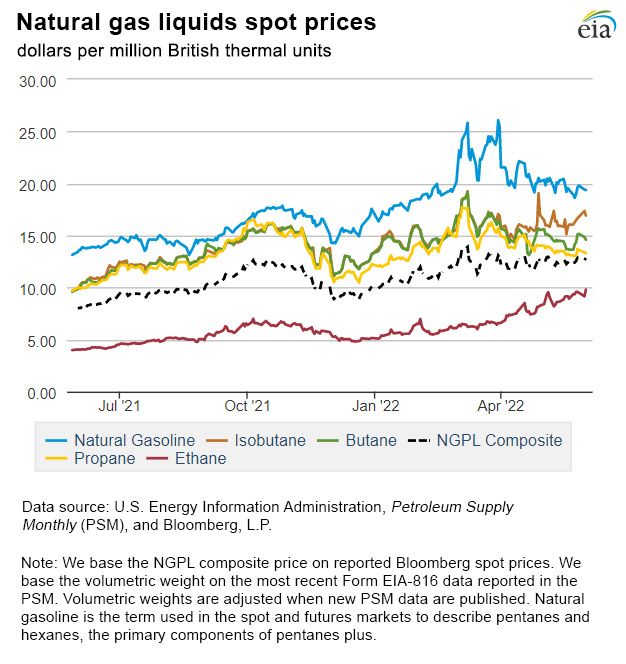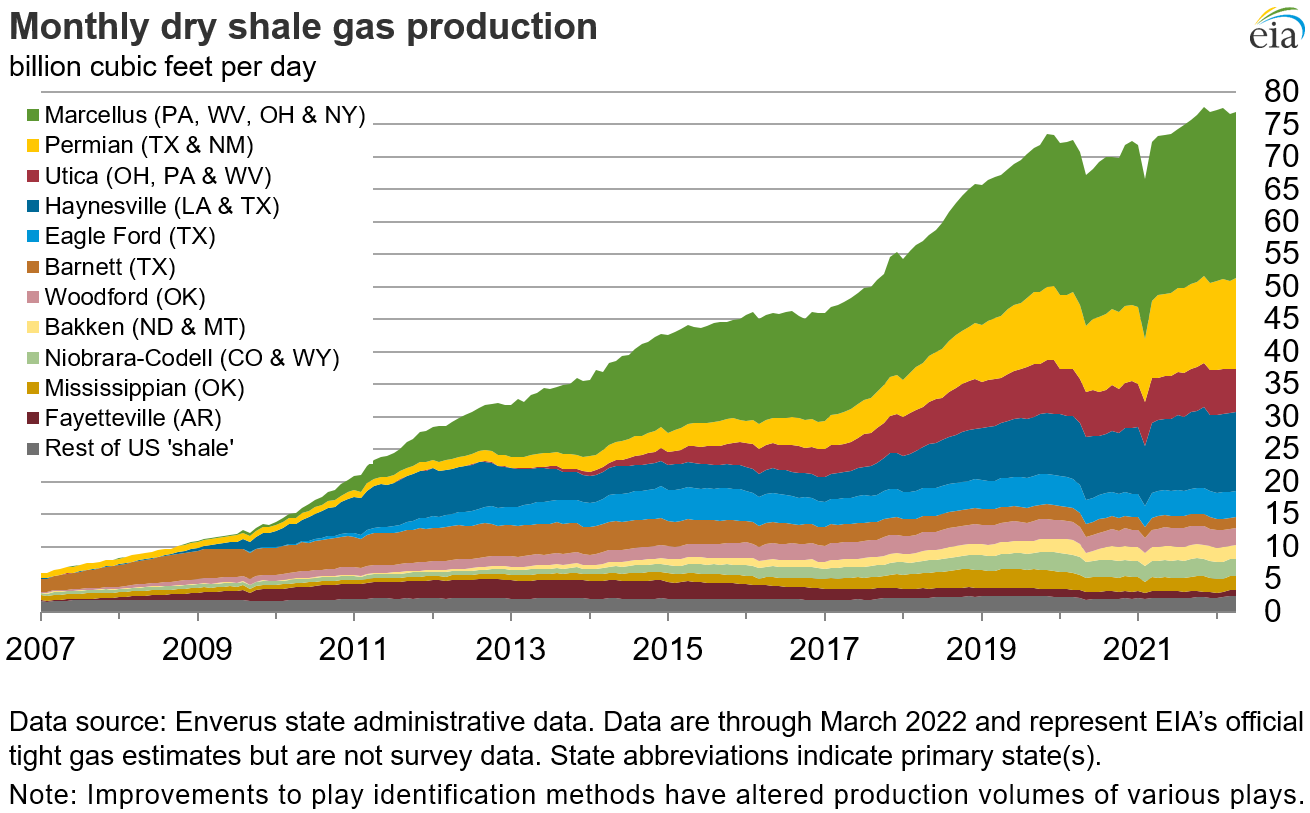In the News:
Record U.S. natural gas demand this winter led to the largest storage withdrawal in four years
Net withdrawals of natural gas from storage totaled 2,264 billion cubic feet (Bcf) this winter (November through March), the highest winter natural gas withdrawal since the winter of 2017–2018 and 10% more than the five-year (2016–2017 to 2020–2021) average winter draw according to our recently released Natural Gas Monthly, which includes data through March 2022. Net natural gas withdrawals typically occur from November through March as demand (consumption plus exports) exceeds supply (dry natural gas production plus imports), and natural gas must be drawn from storage to meet this excess demand. Working natural gas storage levels at the end of March 2022 were 1,401 Bcf, 11 Bcf higher than March 2018.
This past winter, U.S. demand for natural gas exceeded supply of natural gas by an average 14.9 billion cubic feet per day (Bcf/d). Averages of both U.S. supply and demand of natural gas set records this past winter at 104.3 Bcf/d and 119.2 Bcf/d, respectively. However, the supply and demand imbalance was greater in the winter of 2017–2018, resulting in a larger withdrawal from natural gas storage compared with this past winter.
U.S. dry natural gas production increased this winter compared with last winter and averaged 95.6 Bcf/d, close to its highest winter level of 96.0 Bcf/d in 2019–2020. Production has been generally increasing since 2020, after declining because of lower prices and reduced natural gas demand, but natural gas production during the winter did not reach its pre-COVID-19 pandemic level. Imports of natural gas also increased this winter, averaging 8.7 Bcf/d.
U.S. consumption of natural gas rose to 99.5 Bcf/d this winter―just 0.4 Bcf/d below the 2018–2019 winter record―because of higher natural gas consumption in the electric power sector, which rose by 2.0 Bcf/d compared with last winter and by 2.5 Bcf/d compared with the winter of 2018–2019. In addition, a colder-than-normal January contributed to above-average storage withdrawals for that month. Total demand, which includes domestic consumption and exports, was the highest on record this winter averaging 119.2 Bcf/d. A 2.0 Bcf/d rise in exports drove the growth, most of which was due to a 1.8 Bcf/d rise in liquefied natural gas (LNG) exports.
Overview:
(For the week ending Wednesday, June 1, 2022)
- Spot prices: Natural gas spot prices fell at most locations this report week (Wednesday, May 25 to Wednesday, June 1). The Henry Hub spot price fell from $9.30 per million British thermal units (MMBtu) last Wednesday to $8.42/MMBtu yesterday.
- International spot prices: International natural gas spot prices increased this report week. Bloomberg Finance, L.P., reports that the swap prices for liquefied natural gas (LNG) cargoes in East Asia rose $1.89/MMBtu to a weekly average of $23.77/MMBtu. At the Title Transfer Facility (TTF) in the Netherlands, the most liquid natural gas spot market in Europe, the day-ahead price rose 59 cents/MMBtu to a weekly average of $26.51/MMBtu. In the same week last year (week ending June 2, 2021), the prices in East Asia and at TTF were $10.54/MMBtu and $9.12/MMBtu, respectively.
- Futures: The June 2022 NYMEX contract expired last Thursday, May 26, at $8.908/MMBtu, down 6 cents from the previous day. The July 2022 NYMEX contract price decreased to $8.696/MMBtu, down 30 cents from last Wednesday to yesterday. The price of the 12-month strip averaging July 2022 through June 2023 futures contracts declined 15 cents to $7.688/MMBtu.
- Storage: The net injections to working gas totaled 90 billion cubic feet (Bcf) for the week ending May 27. Working natural gas stocks totaled 1,902 Bcf, which is 17% lower than the year-ago level and 15% lower than the five-year (2017–2021) average for this week.
- NGPLs: The natural gas plant liquids composite price at Mont Belvieu, Texas, rose by 41 cents/MMBtu, averaging $12.83/MMBtu for the week ending June 1. Weekly average ethane prices rose 2%, following the 1% increase in natural gas prices at the Houston Ship Channel. The ethane premium to natural gas widened by 18%. The price of ethylene rose 1%, which narrowed the ethylene to ethane spread by 4% due to the larger relative increase in ethane price. The Brent crude oil price rose 5%, pulling up the prices of heavier natural gas liquids. Normal butane and isobutane prices rose 7% and 5%, respectively. The natural gasoline price rose 2%. The propane price rose 3%, widening the propane discount to crude oil by 8%.
- Rigs: According to Baker Hughes, for the week ending Tuesday, May 24, the natural gas rig count increased by 1 rig from a week ago to 151 rigs. One rig was added in the Arkoma Woodford, and the rig count in all other regions remained flat week over week. The number of oil-directed rigs decreased by 2 rigs to 574 rigs. The Cana Woodford, the DJ-Niobrara, the Eagle Ford, and the Mississippian each added one rig. One rig each was dropped in the Granite Wash, the Haynesville, and the Permian, and three rigs were dropped in unspecified producing regions. The total rig count now stands at 727 and is 270 rigs more than the same week last year.
Prices/Supply/Demand:
Prices along the Gulf Coast fall as temperatures remain close to normal, consumption falls in all sectors, and LNG exports decrease. This report week (Wednesday, May 25 to Wednesday, June 1), the Henry Hub spot price fell 88 cents from $9.30/MMBtu last Wednesday to $8.42/MMBtu yesterday. Prices across the South were lower this week, as temperatures remained nearer to normal. Natural gas consumption in all sectors along the Gulf Coast and across the Southeast fell by 0.3 billion cubic feet per day (Bcf/d) (1%) this report week, while deliveries to LNG export terminals in South Texas and South Louisiana fell by 0.2 Bcf/d (1%) to 11.6 Bcf/d, according to data from PointLogic. Temperatures in the Houston Area averaged 82°F this report week, 2°F higher than normal.
Prices in the Midwest decrease as temperatures increase and demand for natural gas declines. At the Chicago Citygate, the price decreased 73 cents from $8.93/MMBtu last Wednesday to $8.20/MMBtu yesterday. Temperatures in the Chicago Area averaged 70°F this report week, 8°F higher than last report week (62°F), and 5°F higher than normal. Natural gas consumption in the residential and commercial sectors in the Midwest decreased by 0.9 Bcf/d (32%) this report week, while consumption in the industrial sector decreased by 0.2 Bcf/d (5%), according to data from PointLogic.
Prices across the West fall in line with the national average. The price at PG&E Citygate in Northern California fell 76 cents, down from $10.37/MMBtu last Wednesday to $9.61/MMBtu yesterday, as prices at major origin points for natural gas into the PG&E service territory also fell. The price at Malin, Oregon, the northern delivery point into the PG&E service territory, fell 58 cents from $9.07/MMBtu last Wednesday to $8.49/MMBtu yesterday. The price at Opal in southwest Wyoming, the origin point of the Ruby Pipeline that delivers natural gas into the Malin hub, fell 84 cents from $9.05/MMBtu last Wednesday to $8.21/MMBtu yesterday. The price at Sumas on the British Columbia/Washington border, the main pricing point for natural gas into the Pacific Northwest, fell 70 cents from $8.82/MMBtu last Wednesday to $8.12/MMBtu yesterday. Temperatures across much of the West were closer to normal this report week, though they remain slightly below normal. Temperatures in the Seattle City Area averaged 57°F this report week, 2°F lower than normal. Natural gas consumption in all sectors of the Pacific Northwest fell this week by 0.1 Bcf/d (8%), according to data from PointLogic.
The price at SoCal Citygate in Southern California decreased $1.11 from $10.11/MMBtu last Wednesday to $9.00/MMBtu yesterday. Temperatures in the Riverside Area, inland from Los Angeles, averaged 69°F this report week, 1°F lower than normal. Natural gas consumption in the electric power sector in California decreased by 0.3 Bcf/d (20%), according to data from PointLogic.
Northeast prices decrease as mild weather on average for the week results in lower consumption. At the Algonquin Citygate, which serves Boston-area consumers, the price went down 19 cents from $9.03/MMBtu last Wednesday to $8.84/MMBtu yesterday. At the Transcontinental Pipeline Zone 6 trading point for New York City, the price decreased 38 cents from $8.23/MMBtu last Wednesday to $7.85/MMBtu yesterday. According to data from PointLogic, natural gas consumption in all sectors in the Northeast fell by 0.7 Bcf/d (5%) from a week ago, led by a 15% decrease in consumption in the residential and commercial sectors. Temperatures in the Boston and New York areas were above normal, resulting in lower heating demand.
Prices in the Appalachian production region fall as in-region demand decreases. The Tennessee Zone 4 Marcellus spot price decreased 35 cents from $7.85/MMBtu last Wednesday to $7.50/MMBtu yesterday. The price at Eastern Gas South in southwest Pennsylvania fell 49 cents from $8.11/MMBtu last Wednesday to $7.62/MMBtu yesterday. Natural gas consumption in the Appalachian production region fell by 0.5 Bcf/d (8%), led by an 11% decrease in consumption in the electric power sector week over week, according to data from PointLogic. Production in the Appalachian Basin increased 0.5 Bcf/d (2%) week over week.
Prices in the Permian production region fall by more than the Henry Hub week over week, widening the discount to Henry Hub. The price at the Waha Hub in West Texas, which is located near Permian Basin production activities, fell $1.17 this report week, from $8.73/MMBtu last Wednesday to $7.56/MMBtu yesterday. The Waha Hub traded 86 cents below the Henry Hub price yesterday, compared with last Wednesday when it traded 57 cents below the Henry Hub price.
U.S. natural gas supply increases week over week. Overall U.S. natural gas supply rose by 0.4% (0.4 Bcf/d) compared with the previous report week, largely due to increased production from the Appalachian Basin, according to data from PointLogic. Dry natural gas production grew by 0.5% (0.5 Bcf/d), and average net imports from Canada decreased by 2.7% (0.1 Bcf/d) from the previous report week.
U.S. natural gas demand falls as temperatures moderate toward normal. Total U.S. consumption of natural gas fell by 4.3% (2.7 Bcf/d) compared with the previous report week, according to data from PointLogic. Temperatures have generally moderated across the United States despite some isolated pockets of higher- and lower-than-normal temperatures. The residential and commercial sectors accounted for the largest decrease in consumption week over week, falling by 19.7% (2.3 Bcf/d). Natural gas deliveries to U.S. LNG export facilities (LNG pipeline receipts) also fell slightly, averaging 12.8 Bcf/d, or 0.2 Bcf/d lower than last week. Industrial sector consumption declined by 1.8% (0.4 Bcf/d) week over week. Natural gas consumed for power generation also fell slightly, declining by 0.3% (0.1 Bcf/d) week over week. Natural gas exports to Mexico increased by 1.2% (0.1 Bcf/d).
U.S. LNG exports decrease by one vessel this week from last week. Twenty-three LNG vessels (eight from Sabine Pass, four each from Cameron and Corpus Christi, three from Freeport, two from Calcasieu Pass, and one each from Cove Point and Elba Island) with a combined LNG-carrying capacity of 85 Bcf departed the United States between May 26 and June 1, according to shipping data provided by Bloomberg Finance, L.P.
Storage:
The net injections into storage totaled 90 Bcf for the week ending May 27, compared with the five-year (2017–2021) average net injections of 100 Bcf and last year's net injections of 100 Bcf during the same week. Working natural gas stocks totaled 1,902 Bcf, which is 337 Bcf lower than the five-year average and 397 Bcf lower than last year at this time.
According to The Desk survey of natural gas analysts, estimates of the weekly net change to working natural gas stocks ranged from net injections of 71 Bcf to 92 Bcf, with a median estimate of 84 Bcf.
The average rate of injections into storage is 10% lower than the five-year average so far in the refill season (April through October). If the rate of injections into storage matched the five-year average of 9.0 Bcf/d for the remainder of the refill season, the total inventory would be 3,308 Bcf on October 31, which is 337 Bcf lower than the five-year average of 3,645 Bcf for that time of year.
More storage data and analysis can be found on the Natural Gas Storage Dashboard and the Weekly Natural Gas Storage Report.
See also:
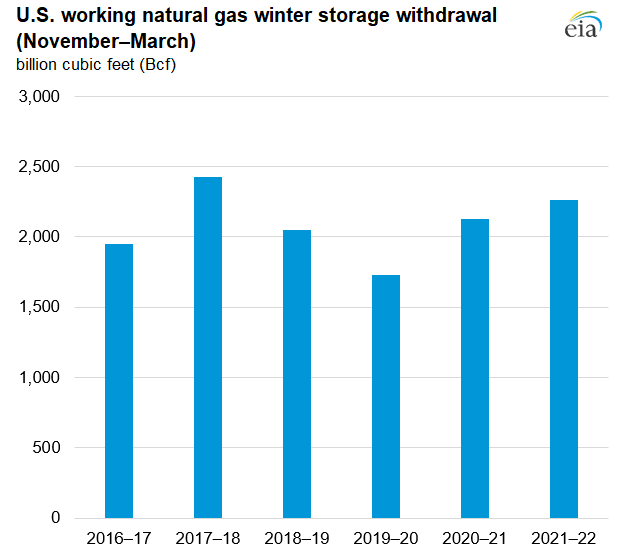
Data source: U.S. Energy Information Administration, Natural Gas Monthly
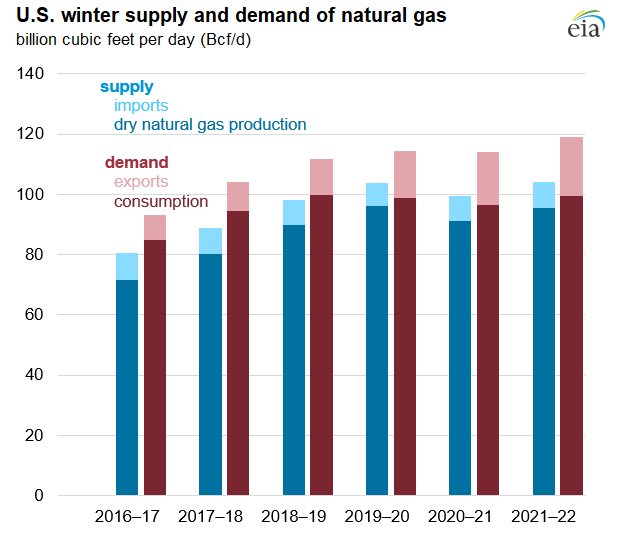
Data source: U.S. Energy Information Administration, Natural Gas Monthly
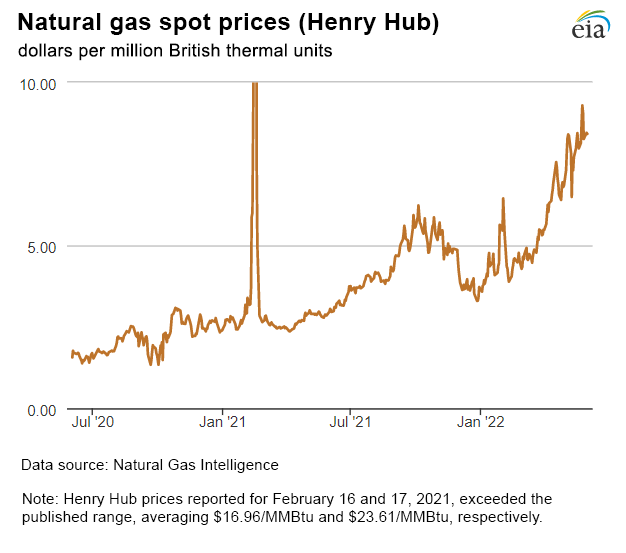
| Spot Prices ($/MMBtu) | Thu, 26-May |
Fri, 27-May |
Mon, 30-May |
Tue, 31-May |
Wed, 1-Jun |
|---|---|---|---|---|---|
| Henry Hub | 9.07 | 8.27 | Holiday | 8.46 | 8.42 |
| New York | 8.16 | 7.71 | Holiday | 7.78 | 7.85 |
| Chicago | 8.65 | 7.81 | Holiday | 8.10 | 8.20 |
| Cal. Comp. Avg.* | 9.43 | 8.54 | Holiday | 8.77 | 8.87 |
| Futures ($/MMBtu) | |||||
| June Contract | 8.908 | Expired | Expired | Expired | Expired |
| July Contract | 8.895 | 8.727 | Holiday | 8.145 | 8.696 |
| August Contract | 8.880 | 8.712 | Holiday | 8.138 | 8.686 |
| *Avg. of NGI's reported prices for: Malin, PG&E Citygate, and Southern California Border Avg. | |||||
| Data source: Natural Gas Intelligence and CME Group as compiled by Bloomberg, L.P. | |||||
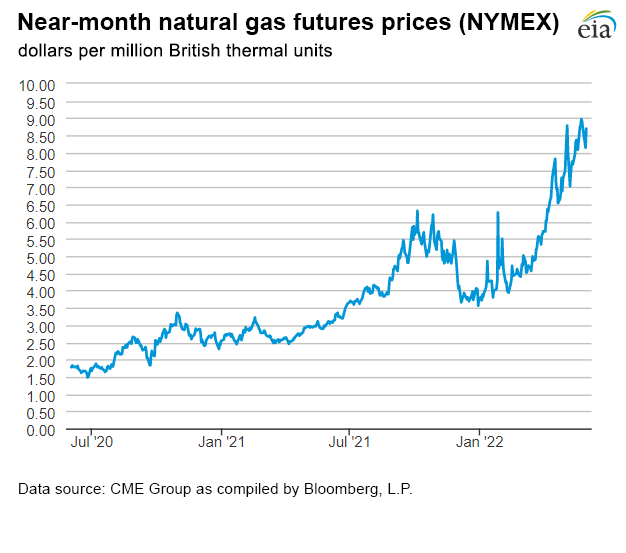
| U.S. natural gas supply - Gas Week: (5/26/22 - 6/1/22) | |||
|---|---|---|---|
Average daily values (billion cubic feet) |
|||
this week |
last week |
last year |
|
| Marketed production | 107.7 |
107.1 |
104.9 |
| Dry production | 95.5 |
95.0 |
92.9 |
| Net Canada imports | 4.8 |
4.9 |
4.0 |
| LNG pipeline deliveries | 0.1 |
0.1 |
0.1 |
| Total supply | 100.4 |
100.0 |
96.9 |
|
Data source: PointLogic | |||
| U.S. natural gas consumption - Gas Week: (5/26/22 - 6/1/22) | |||
|---|---|---|---|
Average daily values (billion cubic feet) |
|||
this week |
last week |
last year |
|
| U.S. consumption | 61.2 |
63.9 |
60.2 |
| Power | 30.5 |
30.6 |
27.5 |
| Industrial | 21.4 |
21.8 |
20.6 |
| Residential/commercial | 9.2 |
11.5 |
12.1 |
| Mexico exports | 5.6 |
5.6 |
6.4 |
| Pipeline fuel use/losses | 6.3 |
6.3 |
6.1 |
| LNG pipeline receipts | 12.8 |
12.9 |
10.6 |
| Total demand | 85.8 |
88.7 |
83.3 |
|
Data source: PointLogic | |||
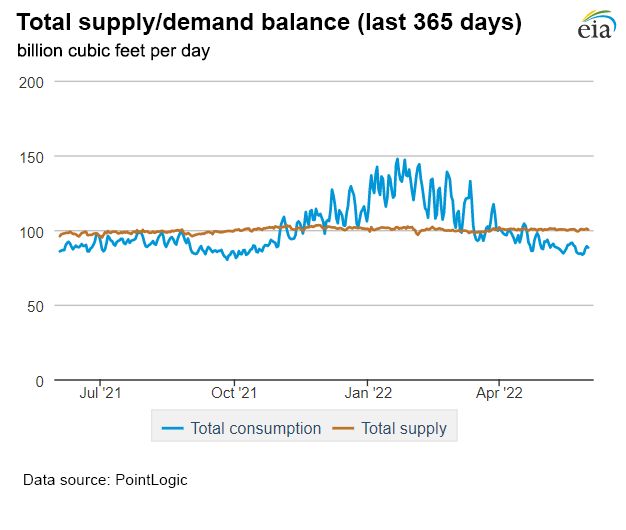
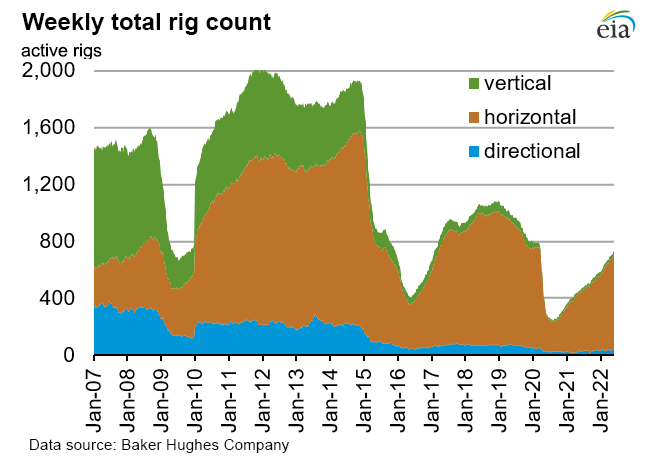
| Rigs | |||
|---|---|---|---|
Tue, May 24, 2022 |
Change from |
||
last week |
last year |
||
| Oil rigs | 574 |
-0.3% |
59.9% |
| Natural gas rigs | 151 |
0.7% |
54.1% |
| Note: Excludes any miscellaneous rigs | |||
| Rig numbers by type | |||
|---|---|---|---|
Tue, May 24, 2022 |
Change from |
||
last week |
last year |
||
| Vertical | 25 |
0.0% |
66.7% |
| Horizontal | 666 |
0.3% |
60.5% |
| Directional | 36 |
-7.7% |
33.3% |
| Data source: Baker Hughes Company | |||
| Working gas in underground storage | ||||
|---|---|---|---|---|
Stocks billion cubic feet (Bcf) |
||||
| Region | 2022-05-27 |
2022-05-20 |
change |
|
| East | 357 |
325 |
32 |
|
| Midwest | 420 |
391 |
29 |
|
| Mountain | 113 |
109 |
4 |
|
| Pacific | 195 |
190 |
5 |
|
| South Central | 817 |
797 |
20 |
|
| Total | 1,902 |
1,812 |
90 |
|
|
Data source: U.S. Energy Information Administration Form EIA-912, Weekly Underground Natural Gas Storage Report | ||||
| Working gas in underground storage | |||||
|---|---|---|---|---|---|
Historical comparisons |
|||||
Year ago (5/27/21) |
5-year average (2017-2021) |
||||
| Region | Stocks (Bcf) |
% change |
Stocks (Bcf) |
% change |
|
| East | 409 |
-12.7 |
418 |
-14.6 |
|
| Midwest | 519 |
-19.1 |
494 |
-15.0 |
|
| Mountain | 150 |
-24.7 |
133 |
-15.0 |
|
| Pacific | 266 |
-26.7 |
245 |
-20.4 |
|
| South Central | 955 |
-14.5 |
948 |
-13.8 |
|
| Total | 2,299 |
-17.3 |
2,239 |
-15.1 |
|
| Data source: U.S. Energy Information Administration Form EIA-912, Weekly Underground Natural Gas Storage Report | |||||
| Temperature – heating & cooling degree days (week ending May 26) | ||||||||
|---|---|---|---|---|---|---|---|---|
HDDs |
CDDs |
|||||||
| Region | Current total |
Deviation from normal |
Deviation from last year |
Current total |
Deviation from normal |
Deviation from last year |
||
| New England | 28 |
-18 |
11 |
13 |
11 |
-6 |
||
| Middle Atlantic | 19 |
-15 |
15 |
20 |
12 |
-11 |
||
| E N Central | 36 |
-5 |
35 |
14 |
-2 |
-40 |
||
| W N Central | 69 |
34 |
62 |
3 |
-17 |
-36 |
||
| South Atlantic | 5 |
-7 |
4 |
71 |
23 |
7 |
||
| E S Central | 4 |
-7 |
4 |
59 |
20 |
-1 |
||
| W S Central | 8 |
6 |
7 |
64 |
-3 |
-4 |
||
| Mountain | 79 |
31 |
27 |
26 |
-1 |
10 |
||
| Pacific | 19 |
-12 |
-25 |
9 |
0 |
9 |
||
| United States | 29 |
-1 |
15 |
33 |
5 |
-8 |
||
|
Data source: National Oceanic and Atmospheric Administration Note: HDDs=heating degree days; CDDs=cooling degree days | ||||||||
Average temperature (°F)
7-day mean ending May 26, 2022
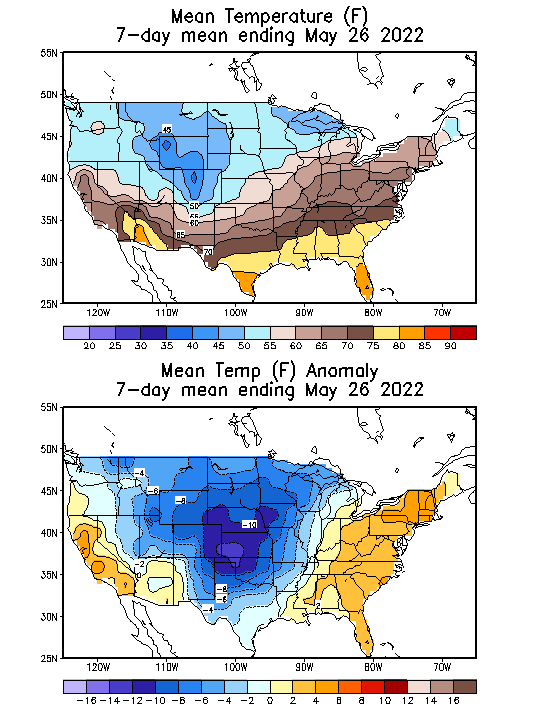
Data source: National Oceanic and Atmospheric Administration
Deviation between average and normal temperature (°F)
7-day mean ending May 26, 2022

Data source: National Oceanic and Atmospheric Administration

